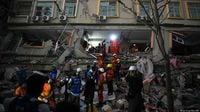The toll from Myanmar's earthquake continues to rise, as foreign rescue teams and aid rushed into the impoverished country, where hospitals were overwhelmed and communities scrambled to mount rescue efforts with limited resources. More than 1,700 people have been confirmed dead following a devastating 7.7-magnitude earthquake that struck near Mandalay on March 28, 2025. The quake, which is the deadliest disaster to hit Myanmar in over 100 years, has left approximately 3,408 injured and 139 missing.
As the situation develops, the International Federation of Red Cross and Red Crescent Societies has launched an emergency appeal for $115 million to assist 100,000 people across 20,000 households with life-saving relief and early recovery support. The World Health Organization has classified the aftermath of the earthquake as a Grade 3 emergency and is seeking $8 million to address health challenges in Myanmar.
Rescue operations have been hampered by significant damage to critical infrastructure, including the historic Ava Bridge connecting Sagaing and Mandalay, and various heritage sites. Airports in Mandalay and Naypyitaw remain closed, complicating efforts to deliver aid. The United Nations has reported severe shortages of medical supplies, and the local health care system is overwhelmed.
In the wake of the disaster, several countries have pledged humanitarian aid to Myanmar. India has launched "Operation Brahma," deploying military aircraft to deliver essential supplies and an 80-member search and rescue team from the National Disaster Response Force. China has also sent multiple ships with rescue teams and supplies, while the United Kingdom has committed up to £10 million in humanitarian aid.
Despite these efforts, reports indicate that the military junta has continued airstrikes in the country, with a recent attack in Naungcho, northern Shan state, resulting in the deaths of seven people just hours after the earthquake struck. This has drawn condemnation from various armed resistance groups, including the Karen National Union, which accused the junta of prioritizing military actions over relief efforts.
In Thailand, the earthquake has claimed at least 18 lives, primarily due to a collapsed skyscraper in Bangkok. Emergency crews resumed searches for 76 individuals believed to be trapped under the rubble. The Thai government has assured that financial services and manufacturing operations are functioning normally, with no significant disruptions reported.
The tremors from the earthquake have also been felt in neighboring countries, raising concerns about structural integrity, particularly in Bangkok, where fewer than 10% of buildings are designed to withstand earthquakes. Experts warn that the soft soil in the area could amplify ground shaking, increasing the risk of further collapses.
As Myanmar continues to grapple with the aftermath of this catastrophic event, the situation remains fluid. The anti-coup fighters, known as the People’s Defence Force, have announced a two-week ceasefire in areas affected by the earthquake to facilitate rescue and relief operations. Their cooperation with international aid organizations aims to ensure the safety of relief efforts amidst ongoing conflict.
Local residents in Myanmar have been the primary responders in the search for survivors, clearing rubble by hand in extreme heat, as heavy machinery is scarce. Reports describe the smell of decaying bodies permeating the streets of Mandalay, where the community is left to fend for itself in the absence of adequate support from the military-led government.
The earthquake is a stark reminder of Myanmar's vulnerability, sitting atop the north-south Sagaing Fault, which separates the India and Sunda tectonic plates. This geological instability has historically resulted in significant seismic activity, with the last major quake of similar magnitude occurring in 1912. The ongoing civil unrest and the military junta's actions complicate the recovery efforts and exacerbate the humanitarian crisis.
As the international community rallies to provide support, the full extent of the destruction caused by the earthquake may take weeks to ascertain. Humanitarian organizations are urging immediate action to address the dire needs of the affected populations, emphasizing the importance of coordinated efforts to deliver aid effectively and efficiently.
In summary, the earthquake that struck Myanmar has resulted in a tragic loss of life and widespread devastation, prompting a global response to assist those affected. The challenges of delivering aid in a conflict-ridden environment underscore the urgent need for a unified effort to support recovery and rebuilding in the months ahead.







